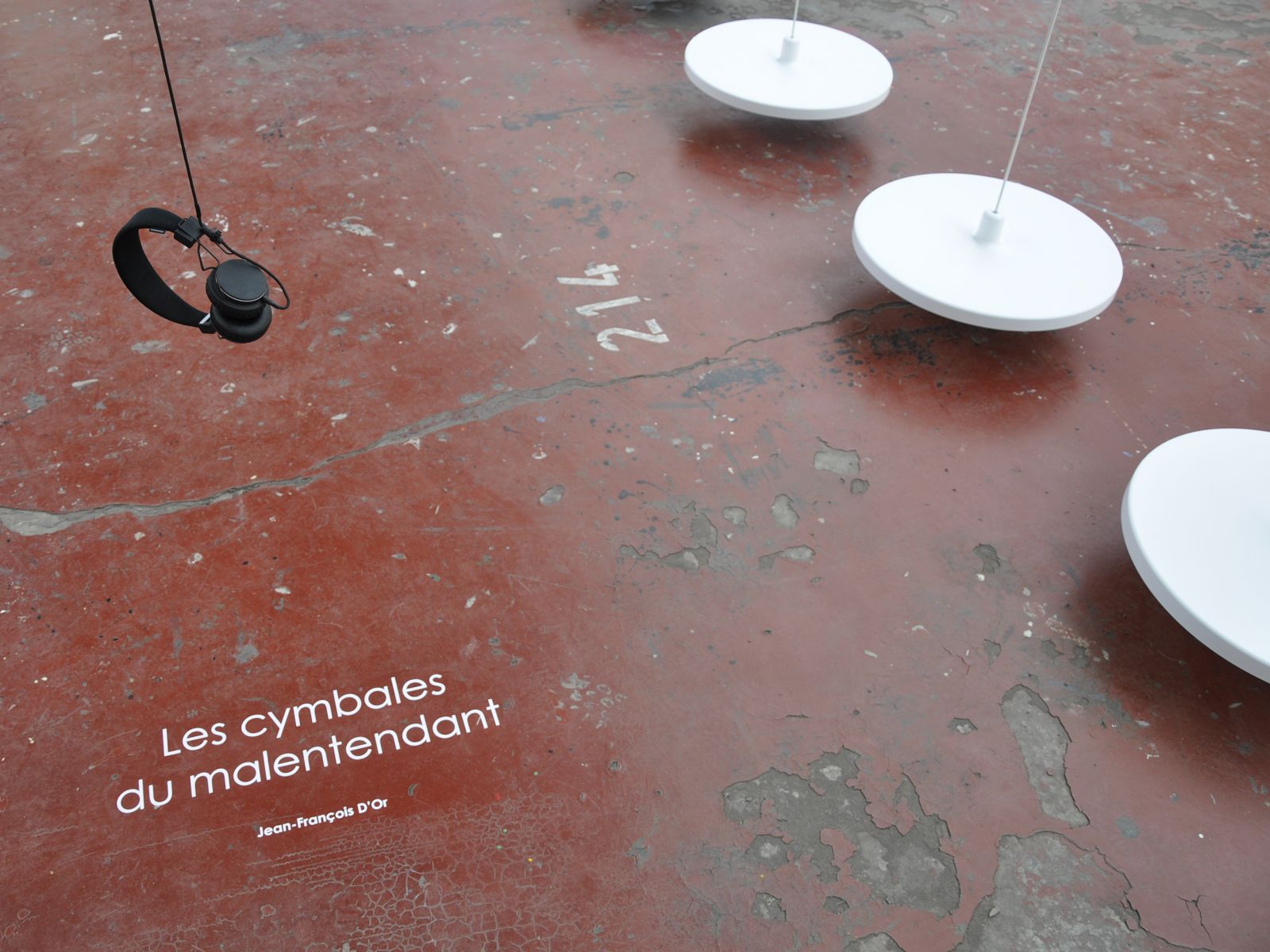Les cymbales du malentendant
for
Centre Pompidou
by Jean-François D'Or

KANAL Centre Pompidou / Installation
Via un dispositif informatique complexe, les rythmes joués par un percussionniste sont mués en impulsions électriques alimentant 20 lampes devenues cymbales. Le son se transforme en intensité lumineuse, silencieux clair obscur. Ambiguïté entre absence de son et éclairage diffus. En détournant ses propres lampes, inspirées elles mêmes par des cymbales, Jean-François D’Or glisse avec brio du design d’objet à l’installation artistique, la boucle est bouclée.
Les cymbales du malentendants.
EN
Via a complex computer device, the rhythms played by a percussionist are transformed into electrical impulses powering 20 lamps that have become cymbals. The sound becomes luminous intensity, silent clair obscur. Ambiguity between absence of sound and diffuse lighting. By diverting his own lamps, themselves inspired by cymbals, Jean-François D’Or brilliantly slides from object design to artistic installation, the circle is complete.
Cymbals for the deaf.

Alternance de pénombre et de lumière rasante saupoudrant le sol. Le son se transforme en intensité lumineuse. Ambiguïté entre absence de son et éclairage diffus, entre rythmes sonores et vitesse de la lumière.
EN
Alternation of half-light and low light sprinkling the ground. Sound transforms into luminous intensity. Ambiguity between absence of sound and diffuse lighting, between sound rhythms and speed of light.
INSTALLATION /
Concept and scenario by Jean-François D'Or.
Drums composition by Louis Favre.
Software and hardware by Emmanuel Mathot.
MATERIAL /
20 DISK lamps D60cm / Coated aluminium / Electrical cables / Software.
DIMENSIONS /
H 800 x L 2000 x 60 cm.
VIDEO /
See video above and below.
PRICE /
Contact us to get prices and delivery time.
EXHIBITION /
Between Art & Design, the Belgian scene exhibition, Centre Pompidou Kanal Brussels.
Text © Jean-Michel Leclercq.
Video © Julien Henry.
Pictures © Julien Henry © LOUDORDESIGN studio.


Des casques audio sont mis à disposition afin de proposer une seconde lecture. Les visiteurs y entendent le son des percussions et visualisent la simultanéité des rythmes d'intensités lumineuses. Interaction, dialogue, rencontre et résonance avec l'emblématique architecture de ce Centre Pompidou Bruxellois.
EN
Headphones are made available to obtain a second reading. Visitors hear the sound of percussion and visualize the simultaneity of rhythms of luminous intensities. Interaction, dialogue, encounter and resonance with the emblematic architecture of this Brussels Pompidou Center.






This subjective selection focuses on a specific niche in the design sector, that of collectible design. Limited series and unique pieces, sometimes hand-made, form the core of this exhibition, in which form takes precedence over functionality, which is relegated to the background. The selection includes objects in the grey zone between art and design. The various pieces exhibited testify to the eclecticism and influence of Belgian creativity.
The tension between these two fundamental aspects of design was a key element in the selection of the items for the show. Function often plays an invisible role so that our focus is drawn exclusively to the form of an object. This tension also comes up in the research into and experiments in the techniques and materials used. The result is always a very personal design language. The common demands of any piece of furniture are not given priority here. The objects are no longer reduced to function alone, they are unconventional and anarchic; they invite interaction.
It offers us an ensemble that reflects the wealth and particularly the diversity of contemporary Belgian design. In this selection, the most striking aspect is the great artistic diversity that is also a strong characteristic of the world of visual arts in Belgium. The designers adopt a very independent and individual presentation style. They experiment with various techniques and materials and are consequently involved in the production process. But diversity is not just the result of an unusual choice of materials, technique or design language. It is also about peoples perception of an object. It may surprise, disturb or even amuse.
Belgian designers remain, with a few exceptions, understated; their work is rarely obtrusive but truly characterized by a feeling for aesthetics, volume and proportion. And even that is their strength.
Les cymbales du malentendant. Jean-François D'Or. Centre Pompidou Kanal.
Text by Jean-Michel Leclercq.


INSTALLATION /
Concept and scenario by Jean-François D'Or.
Drums composition by Louis Favre.
Software and hardware by Emmanuel Mathot.
MATERIAL /
20 DISK lamps D60cm / Coated aluminium / Electrical cables / Software.
DIMENSIONS /
H 800 x L 2000 x 60 cm.
VIDEO /
See video above and below.
PRICE /
Contact us to get prices and delivery time.
EXHIBITION /
Between Art & Design, the Belgian scene exhibition, Centre Pompidou Kanal Brussels.
Text © Jean-Michel Leclercq.
Video © Julien Henry.
Pictures © Julien Henry © LOUDORDESIGN studio.



